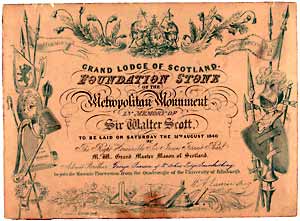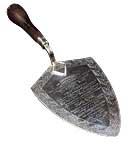 |
The supervision of building construction was entrusted
to George Meikle Kemp, and the contract was assigned to Mr David
Lind who had previously built the Tolbooth Church on Castlehill.
It was also decided to use Binny sandstone from Uphall, West Lothian
to build it.
Kemp had convinced the Committee to allow a foundation on bedrock
to be excavated, due to the proposed height of the monument and
the fact that the Caledonian Railway Company proposed to tunnel
under Princes Street within eight feet (2.6m) of the foundation.
He then invited several friends to witness the laying of the 'real'
foundation stone.
A letter was sent out inviting Freemasons to attend the official
ceremony of the Laying of the Foundation Stone of the ‘Metropolitan
Monument’ - the Scott Monument. The letter reads:
Crown and Anchor Tavern, Edinburgh 8th August 1840
Sir and Brother
I am directed by the Right Worshipful Master of the Edinburgh Lodge
Saint Andrews, to inform you that the Foundation Stone of the Metropolitan
Monument in memory of Sir Walter Scott is to be laid with Masonic
Honours, on Saturday 15th, upon which occasion you are respectfully
invited to attend.
The Brethren will assemble in the Quadrangle of the University at
1 o’clock precisely - Costume - Full Dress Black, with White
Gloves, Clothing Dark Blue Sash and Apron, to which it is hoped
that all present will adhere.
No brother can be admitted without a ticket which may be had of
the RWM Bellevue Cottage. The Treasurer, 62 Leith Street, or Brother
Geo Vallance, 11 Register Street, at 11 o’clock forenoon.
The Brethern will dine the same day in the Crown and Anchor Tavern,
High Terrace at 5 o’clock precisely. Ticket 2/6.
The Lodge will meet next Friday evening at half past to make the
final arrangements.
I am, Sir and Brother, Yours Fraternally
R.Stewart
Below is one of the admission tickets sent to the Freemasons.

The text of the ticket reads:
Grand Lodge of Scotland
Foundation Stone of the Metropolitan Monument in memory of Sir Walter
Scott to be laid on Saturday 15th August by The Right Honourable
Sir James Forrest Bart., MW Grand Master Mason of Scotland Admit
Brother George Pearson of St Johns Lodge Inverkeithing to join the
Masonic Procession from the Quadrangle of the University of Edinburgh
Wm. Laurie, Sec[retary]
John Brown sc N.Bridge Edin.
Around the text are depictions of historical Scottish and Gothic
items, such as swords, armour, thistles, the Scottish coat of arms
and at the bottom are Masonic regalia and insignia.
On 15th August 1840, the 69th anniversary of Scotts death, the
official foundation stone was laid. Edinburgh declared a public
holiday and large crowds gathered. In the foundations were deposited
a glass jar 'time capsule' and two bronze plaques - one from the
Freemasons, the other celebrating the author.
 This
silver trowel with a mahogany handle was used during the ceremony
for laying the foundation stone of the monument. It has an engraved
border of a rolling thistle flower and leaf, and on it is written: This
silver trowel with a mahogany handle was used during the ceremony
for laying the foundation stone of the monument. It has an engraved
border of a rolling thistle flower and leaf, and on it is written:
‘To Commemorate the Laying of the Foundation Stone
of the Monument at Edinburgh in honour of the Immortal Scott.
This trowel to be used at the ceremonial was presented to the Right
Honourable Sir James Forrest of Comiston Bart., Lord Provost of
Edinburgh, Most Worshipful Grand Mason over all Scotland.
The Right Worshipful Master, Office Bearers and Brethren of the
Grand Masters Mother Lodge, The Antient Lodge of Edinburgh No.92.
Aug 15th 1840.'
The trowel can be found on display at the Writers’
Museum, Lady Stair’s Close, Lawnmarket, Edinburgh. |



